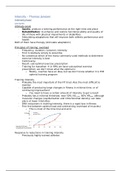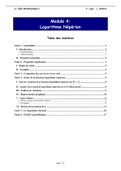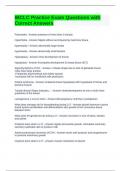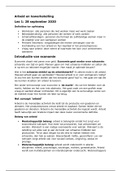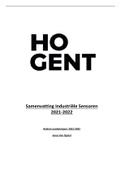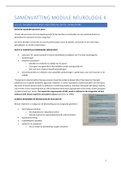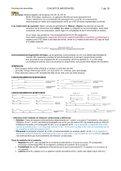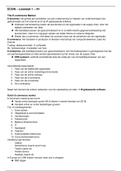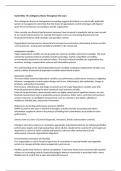Intensity – Thomas Janssen
Intensity/load
Lectures
Ultimate goals
- Sports: produce a winning performance at the right time and place
- Rehabilitation: to enhance and restore functional ability and quality of
life of those with physical impairments or disabilities
- Stimulating adaptations that will improve both athletic performance and
health
Both of them have therapy (stimulate adaptation)
Principles of training: overload
- Frequency, duration, (volume), intensity
- First 3 relatively simply to prescribe
- No consensus which of the many commonly used methods to determine
exercise intensity is best
- Controversy
- Result: sub-optimal exercise prescription
- Training for marathon in 99% we have sub-optimal exercise
prescription; we don’t know what the optimal is
o Mostly, coaches have an idea, but we don’t know whether it is THE
optimal training program
Training intensity
- Probably the most important of the FIT triad. Also the most difficult to
monitor
- Capable of producing large changes in fitness in minimal time, or of
continuing improvement
o You need to have a certain amount of intensity to get a result
- Probably has a minimal threshold, near 50% VO 2 max, 60% HRmax, although
muscular changes (capillarization and mitochondrial density) can take
place at lower intensities
- With reductions in training intensity, there is a rapid loss in fitness
- Fine line between optimal load and overtraining (overload of muscles)
o This is most of the time trial and error
Response to reductions in training intensity
- Previously highly trained athletes
,So when athletes want to train less they reduce frequency not intensity
Exercise intensity (Wikipedia)
“Exercise intensity refers to how much energy is expended when exercising.
Perceived intensity varies with each individual. It has been found that intensity
has an effect on what fuel the body uses and what kind of adaptations the body
makes after exercise. Intensity is the amount of physical power (expressed as a
percentage of the maximal oxygen consumption) that the body uses when
performing an activity. For example, exercise intensity defines how hard the
body has to work to walk a mile in 20 minutes.”
Measuring exercise intensity/load
Parameters related to performance output
- Absolute force/power/velocity
o Coordinated action (e.g. cycling, leg press, lifting weights, speed
during swimming or running). New techniques, e.g. GPS
o “isolated” muscle group (e.g. knee extensor muscles)
Does not say anything about what is happening in the body/muscle
Does not always reflect intensity. Many influencing factors: terrain,
environmental conditions, equipment
- Percentage of maximal force/power output/velocity (%MVC; %P max)
- Critical power
- Team sports? how do you measure intensity in a game?
Parameters related to energy expenditure
- Absolute energy expenditure, VO2, heart rate
- Percentage of max/peak VO2 (%VO2 max, %VO2 peak) or VO2 reserve (%VO2 reserve)
or METs
- Percentage of maximal heart rate (%HRmax) or heart rate reserve (%HRR)
- Anaerobic/lactate/ventilator/gas exchange threshold (AT/LT/VT/GET)
metabolism
Parameters related to subjective feeling (RPE)
(combinations of the above)
Using either maximal submaximal anchor measurements
Opinion about this table
,Guideline, they change it every couple of years
Interpretation: broad range, so do something … they do not say anything about
optimum intensity
- Multiple choices of parameters might be easier to use RPE scale
- More practical to measure
- Combination of parameters might be more beneficial because some are
objective and some are subjective
- Large range within one parameter e.g. 40/50-85% VO2R you can doe
almost anything you want
o Whether the training is optimal for improvement is the question
- Assumed in the beginning that VO2 max and HRR are the same, and which
one would you chose now
- Can you just pick one or do you need to combine them?
If you want to improve you have to do more than you normally do
So when you are in good shape, you have to do much more (maybe at 90%) than
not fit people (they maybe only have to exercise at 40-50%)
Linear relationship between HRR and VO 2 max
Two types of measuring exercise intensity: %HRR and HVO 2
Left: much variation and the intersect is not at 0 strong correlation but two
different parameters!
Unfit people start at higher % of VO2max so for these people it makes more
sense which measurement you take
Middle: more or less perfect relationship. Still variability! Keep this in mind
- In general there is a strong relationship between HRR and VO 2 max, but
there is a lot of variability, a % HRR is not necessarily %VO 2
- Depending on which one you choose, the training result could be different
- Especially in the lower range there is some difference
- The line cannot be through 0 because you always have a VO 2, but HRR can
be 0
- More fit persons have higher VO2, so the %VO2 can be lower
, - To make them even use the %VO2 reserve
- You don’t know which measure is correct (%HRR or %VO 2)
o Based on the measurements you make the decision, but you are not
sure you actually make the right decision
%HRR - %VO2reserve (Da Cunha et al., 2011)
- Most studies: %HRR - %VO2R stronger than %HRR - %VO2 max
o No consistent literature
o Methodological limitations
VO2 max test not adequate
Resting VO2 not measured or incorrectly measured
Stability during prolonged submax exercise questionable
o Da Cunha: advise to use %HRR-%VO2max
Training levels/zones
- Lactate levels
o LT1 the point where lactate starts to
accumulate
- %HRmax
- RPE
Moderate (constant load exercise) stabilization of the
VO2
Heavy zone oxygen uptake will increase more than it should be (slow
component of oxygen uptake) but still a stabilization
- There is a certain VO2 amount corresponding to a power output body
becomes less efficient at higher work levels so there is more VO 2 needed
- Dotted line is what you need and if you are in a perfect shape
Severe zone VO2 no stabilization till VO2 max
Intensity/load
Lectures
Ultimate goals
- Sports: produce a winning performance at the right time and place
- Rehabilitation: to enhance and restore functional ability and quality of
life of those with physical impairments or disabilities
- Stimulating adaptations that will improve both athletic performance and
health
Both of them have therapy (stimulate adaptation)
Principles of training: overload
- Frequency, duration, (volume), intensity
- First 3 relatively simply to prescribe
- No consensus which of the many commonly used methods to determine
exercise intensity is best
- Controversy
- Result: sub-optimal exercise prescription
- Training for marathon in 99% we have sub-optimal exercise
prescription; we don’t know what the optimal is
o Mostly, coaches have an idea, but we don’t know whether it is THE
optimal training program
Training intensity
- Probably the most important of the FIT triad. Also the most difficult to
monitor
- Capable of producing large changes in fitness in minimal time, or of
continuing improvement
o You need to have a certain amount of intensity to get a result
- Probably has a minimal threshold, near 50% VO 2 max, 60% HRmax, although
muscular changes (capillarization and mitochondrial density) can take
place at lower intensities
- With reductions in training intensity, there is a rapid loss in fitness
- Fine line between optimal load and overtraining (overload of muscles)
o This is most of the time trial and error
Response to reductions in training intensity
- Previously highly trained athletes
,So when athletes want to train less they reduce frequency not intensity
Exercise intensity (Wikipedia)
“Exercise intensity refers to how much energy is expended when exercising.
Perceived intensity varies with each individual. It has been found that intensity
has an effect on what fuel the body uses and what kind of adaptations the body
makes after exercise. Intensity is the amount of physical power (expressed as a
percentage of the maximal oxygen consumption) that the body uses when
performing an activity. For example, exercise intensity defines how hard the
body has to work to walk a mile in 20 minutes.”
Measuring exercise intensity/load
Parameters related to performance output
- Absolute force/power/velocity
o Coordinated action (e.g. cycling, leg press, lifting weights, speed
during swimming or running). New techniques, e.g. GPS
o “isolated” muscle group (e.g. knee extensor muscles)
Does not say anything about what is happening in the body/muscle
Does not always reflect intensity. Many influencing factors: terrain,
environmental conditions, equipment
- Percentage of maximal force/power output/velocity (%MVC; %P max)
- Critical power
- Team sports? how do you measure intensity in a game?
Parameters related to energy expenditure
- Absolute energy expenditure, VO2, heart rate
- Percentage of max/peak VO2 (%VO2 max, %VO2 peak) or VO2 reserve (%VO2 reserve)
or METs
- Percentage of maximal heart rate (%HRmax) or heart rate reserve (%HRR)
- Anaerobic/lactate/ventilator/gas exchange threshold (AT/LT/VT/GET)
metabolism
Parameters related to subjective feeling (RPE)
(combinations of the above)
Using either maximal submaximal anchor measurements
Opinion about this table
,Guideline, they change it every couple of years
Interpretation: broad range, so do something … they do not say anything about
optimum intensity
- Multiple choices of parameters might be easier to use RPE scale
- More practical to measure
- Combination of parameters might be more beneficial because some are
objective and some are subjective
- Large range within one parameter e.g. 40/50-85% VO2R you can doe
almost anything you want
o Whether the training is optimal for improvement is the question
- Assumed in the beginning that VO2 max and HRR are the same, and which
one would you chose now
- Can you just pick one or do you need to combine them?
If you want to improve you have to do more than you normally do
So when you are in good shape, you have to do much more (maybe at 90%) than
not fit people (they maybe only have to exercise at 40-50%)
Linear relationship between HRR and VO 2 max
Two types of measuring exercise intensity: %HRR and HVO 2
Left: much variation and the intersect is not at 0 strong correlation but two
different parameters!
Unfit people start at higher % of VO2max so for these people it makes more
sense which measurement you take
Middle: more or less perfect relationship. Still variability! Keep this in mind
- In general there is a strong relationship between HRR and VO 2 max, but
there is a lot of variability, a % HRR is not necessarily %VO 2
- Depending on which one you choose, the training result could be different
- Especially in the lower range there is some difference
- The line cannot be through 0 because you always have a VO 2, but HRR can
be 0
- More fit persons have higher VO2, so the %VO2 can be lower
, - To make them even use the %VO2 reserve
- You don’t know which measure is correct (%HRR or %VO 2)
o Based on the measurements you make the decision, but you are not
sure you actually make the right decision
%HRR - %VO2reserve (Da Cunha et al., 2011)
- Most studies: %HRR - %VO2R stronger than %HRR - %VO2 max
o No consistent literature
o Methodological limitations
VO2 max test not adequate
Resting VO2 not measured or incorrectly measured
Stability during prolonged submax exercise questionable
o Da Cunha: advise to use %HRR-%VO2max
Training levels/zones
- Lactate levels
o LT1 the point where lactate starts to
accumulate
- %HRmax
- RPE
Moderate (constant load exercise) stabilization of the
VO2
Heavy zone oxygen uptake will increase more than it should be (slow
component of oxygen uptake) but still a stabilization
- There is a certain VO2 amount corresponding to a power output body
becomes less efficient at higher work levels so there is more VO 2 needed
- Dotted line is what you need and if you are in a perfect shape
Severe zone VO2 no stabilization till VO2 max

